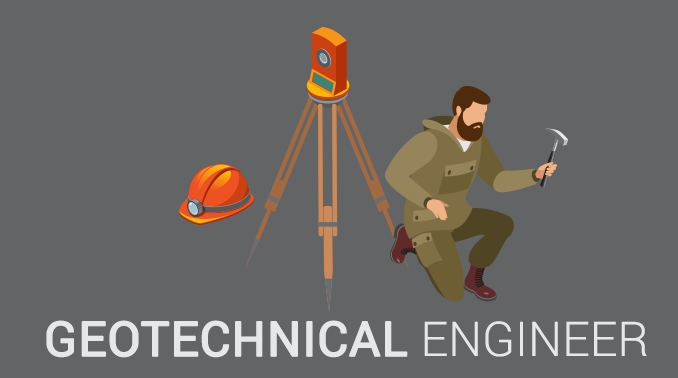The Only Guide for Geotheta
The Only Guide for Geotheta
Blog Article
Geotheta Things To Know Before You Get This
Table of ContentsNot known Details About Geotheta Not known Facts About GeothetaWhat Does Geotheta Mean?The Best Guide To Geotheta
They work together with civil engineers, structural engineers, architects, and various other specialists to incorporate geotechnical factors to consider right into the general project design and building process. This calls for reliable team effort, coordination, and communication to ensure that the geotechnical facets straighten with the job goals and meet governing needs.Mining & Products Engineering: Concepts of boring, penetration prices, and elements impacting the selection of exploration technique. Blowing up techniques in surface and below ground functions. Mechanical and continual techniques to fragmentation, including longwall shearing and fullface boring.
Modelling of fragment and particle dimension distributions; comminution as a transfer function. Comminution technology: squashing, grinding, dimension classification. Integrated analysis of fragmentation and comminution procedures. Offered by: Mining & Materials Design.
The smart Trick of Geotheta That Nobody is Discussing
Bachelor's level programs in civil, geotechnical, geological, and ecological engineering normally last four years and include basic education training courses in English, social scientific research, and the liberal arts, as well as courses in sophisticated maths, architectural geology, and liquid mineralogy. (https://geotheta.blog.ss-blog.jp/2024-08-02?1722614750)
Geotechnical engineering entails the assessment of the dirt and rock problems at a specific website, and their ramifications for the growth of that website. As a lot of frameworks count on the ground for support, it lacks shock that a comprehensive understanding of the ground problems, and the viability of structure systems, are vital to the long-term stability and performance of the building or framework.
Being experts in the examination of geological developments and ground behaviour, geotechnical engineers do clinical examinations and screening to recognize the impact these geological formations may have on the design and building of structure, civil and framework tasks. This know-how is crucial for the design and building of buildings, roads, tunnels, dams, bridges, and water system and sewer system.
The geotechnical group at Douglas Allies regularly seek advice from designers, design designers, developers, and home builders to make referrals on style and advancement proposals to guarantee that the built structures are suitably designed for the ground problems. As an example, the layout of footing systems requires to consider the weight of the structure, the capacity of the ground to sustain that weight along with motion tolerances and efficient building and construction.
The Basic Principles Of Geotheta
This task is greatly streamlined by the use of our Douglas Map geospatial system which makes this info readily obtainable in a simple to make use of web internet browser interface. A geotechnical designer will route the boring of boreholes and test pits to gather dirt and other examples, and likewise examine surface functions and ground direct exposures to form a geotechnical version of the subsurface problems.
Relying on the job type and ground problems ran into, laboratory screening might to name a few points evaluate toughness, compressibility, reactivity and/or permeability of dirt and rock examples. After this data is accumulated and collated, the outcomes are made use of for a geotechnical model of the site, which is typically provided as areas throughout the website.

A geotechnical examination by nature can only assess the ground problems at the places pierced or dug deep into. Natural variants in dirt and rock problems can occur throughout a website and in between examination places. It is consequently excellent practice that the geotechnical designer be retained throughout building of the project to give on-site verification that the ground conditions run into follow the assumptions and recommendations provided in the geotechnical examination record.
Geotheta - An Overview
Geotechnical designers use their thorough knowledge of dirt and rock to examine risk and address problems on diverse infrastructure projectsGeotechnical engineering is a specialist branch of civil design which considers the behaviour of planet materials and the application of soil and rock auto mechanics. Tailings Engineer. As a geotechnical designer, you will examine the physical, mechanical and chemical buildings of soil and rock in order to develop structures, maintaining frameworks and earthworks
Geotechnical design is closely linked to and overlaps with, both engineering geology and ground design - https://geotheta.godaddysites.com/f/why-geotechnical-engineers-are-your-projects-best-friends. It's feasible to specialise in geotechnics or job for a geotechnical business but be recognized as an engineering rock hound or a ground designer. As a geotechnical engineer, you'll need to: develop and keep relationships with clients and other experts entailed in the site, throughout each projectmaintain safety criteria on site be mindful of price ramifications when you make recommendationsstudy explanation geological maps and airborne pictures from an array of resources and from various time periodsexamine construction intends to see exactly how viable they are based upon your understanding of the siteinvestigate threats or geological dangers for the sitesearch for environmentally delicate functions, such as land fill start to create accurate and interpretive ground modelsplan area investigationsdrill and analyse examples of bedrock, soil, groundwater and additional products oversee other experts on sitesolve technical concerns as they occur, such as unforeseen frameworks at drill sitesmonitor conditions throughout and after construction to ensure frameworks are stable in the brief and lengthy termadding data accumulated on website to your preliminary researchcreating geotechnical estimations, drawings, and 2 or three-dimensional computer designs translating the datamaking recommendations concerning the proposed usage of the site

Report this page